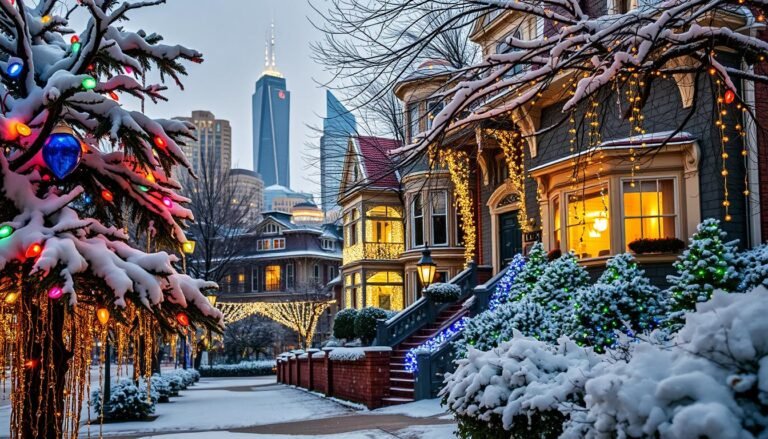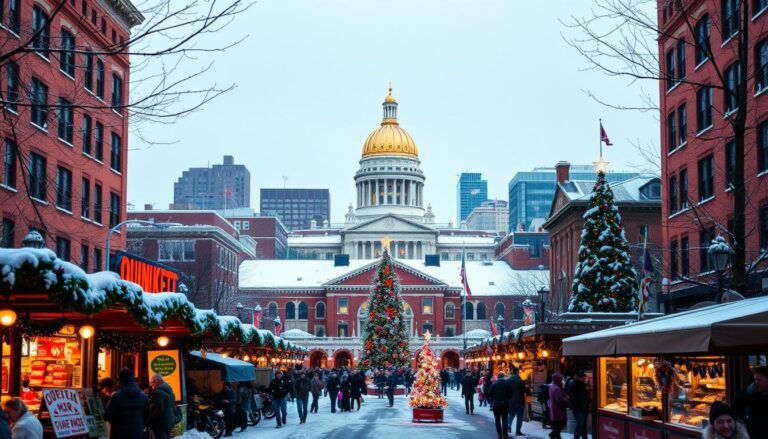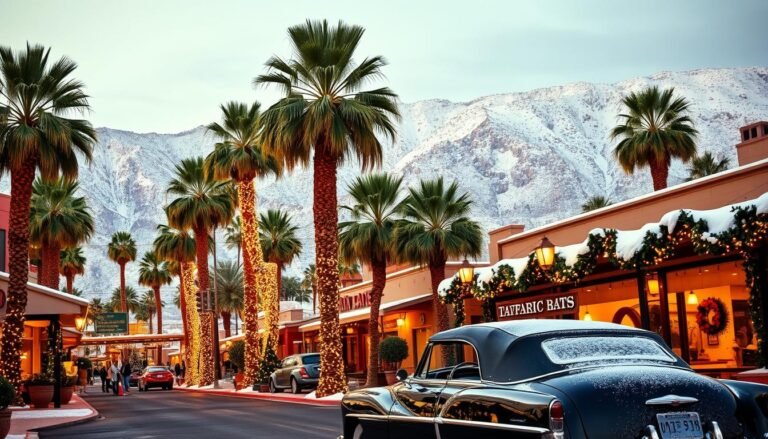Uncover the Unique Christmas Tradition in Sweden
As the darkness of November descends upon Sweden, the arrival of December brings a surge of warmth and light. Swedes welcome the holiday season by hanging lit paper stars in their windows and lighting Advent candles, symbolizing the triumph of light over darkness. This is a guide for Christmas Tradition in Sweden.
But what makes Swedish Christmas celebrations so unique? As we explore the enchanting world of Swedish traditions, we’ll discover how ancient pagan customs blend with Christian practices, creating a distinctive winter experience.
We’ll examine the crucial role of light in these traditions, serving both practical and symbolic purposes during the darkest time of the year.
Key Takeaways
- Explore how Swedish Christmas celebrations blend ancient pagan customs with Christian traditions.
- Discover the significance of light in Swedish Christmas traditions.
- Learn about the timeline of Swedish Christmas celebrations.
- Understand how Swedish expatriates maintain their cultural heritage.
- Examine the unique elements that make Swedish Christmas traditions stand out.
The Magic of Swedish Christmas: A Winter Wonderland
As December descends upon Sweden, the country transforms into a winter wonderland, filled with twinkling lights and festive traditions. The extreme darkness of Swedish winters, especially in the northern regions where polar nights are experienced, makes light a central element in Christmas decorations and traditions.

The psychological impact of light during winter is profound, explaining why Swedes enthusiastically embrace candles, stars, and illuminated decorations during the holiday season. This embrace of light is not just aesthetic; it creates a cozy atmosphere that embodies the Swedish concept of “mysigt,” making the cold winter months more bearable.
The Importance of Light in the Dark Swedish Winter
The darkness of Swedish winter is countered by the warm glow of candles and the twinkle of lights in every window. This tradition is not just visually pleasing; it has a deep psychological impact, helping to alleviate the gloom of the long winter nights.
When Christmas Season Begins in Sweden
The Christmas season in Sweden officially begins with “Första Advent” or First Advent, a tradition that marks the start of the countdown to Christmas. On this day, Swedes place electric candle arches and star-shaped paper lanterns in their window, signaling the beginning of the festive season.
St. Lucia’s Day: The Festival of Light
As the darkness of winter descends upon Sweden, the celebration of St. Lucia’s Day brings a burst of light and joy to the season. This cherished tradition is observed on December 13th, marking the beginning of the Christmas season in Sweden.

The History and Legend of St. Lucia
St. Lucia was a young Christian girl who was martyred in 304 AD for her faith. According to legend, she would secretly bring food to persecuted Christians in Rome, wearing lighted candles on her head to free her hands. This act of bravery and kindness has been immortalized in Swedish culture, symbolizing the triumph of light over darkness.
The Traditional Celebration on December 13th
On the 13th of December, Swedish schools and communities come together to celebrate St. Lucia’s Day. A girl is chosen to represent St. Lucia, dressed in a white robe with a red sash and a crown of candles, symbolizing light in the darkness. This tradition is a meaningful way to involve children in the festive spirit.
Lucia Processions and Lussekatter Buns
The celebration includes Lucia processions where carols are sung, and the traditional Lussekatter buns are enjoyed. These saffron-flavored, S-shaped bread-like treats are dotted with raisins and are a beloved part of the holiday tradition. While some may confuse them with cookies, Lussekatter are a distinct and delicious aspect of St. Lucia’s Day festivities.
Advent Celebrations and Decorations
As Christmas approaches, Sweden comes alive with unique Advent celebrations and decorations that reflect the country’s rich cultural heritage. The season is marked by a growing sense of anticipation and festivity, with homes and public spaces adorned with traditional decorations.
Advent Stars and Candles in Windows
One of the most iconic Swedish Advent decorations is the Advent star (julstjärna), typically made from paper or straw and featuring seven or nine points. These stars, often illuminated from within, are hung in windows to symbolize the star that guided the wise men to Bethlehem. The tradition of making Advent stars dates back to the 1930s and has since become an integral part of Swedish Christmas decorations. Additionally, many Swedish homes light Advent candles on the four Sundays leading up to Christmas, creating a warm and inviting ambiance.

The Yule Goat Tradition and the Famous Gävle Goat
The Yule Goat (Julbock) is another significant Advent tradition in Sweden, with roots in pre-Christian pagan customs. The modern incarnation of this tradition is often seen in the form of straw decorations, including the famous Gävle Goat. Constructed annually since 1966, the Gävle Goat is a massive 13-meter straw goat that has become a popular tourist attraction, despite being frequently vandalized over the years. Smaller straw decorations, including Yule goats and stars, are also used to adorn Swedish homes, serving as a reminder of the humble manger where Jesus was born.
Swedish Christmas tree decorations also differ from those in other countries, often featuring straw ornaments, small red wooden horses, and real candles in traditional homes, adding to the unique charm of the Swedish Christmas tradition.
Also Read Best Christmas Gift Ideas for Mom in 2025
Christmas Eve: The Heart of Christmas Tradition in Sweden
In Sweden, Christmas Eve is the main event, a day when families gather to enjoy a traditional feast and participate in time-honored customs. This day is the pinnacle of the Christmas season, filled with activities that bring together generations and blend old traditions with new ones.

The Julbord: Sweden’s Christmas Feast
The julbord, or Christmas table, is a grand feast that is central to Swedish Christmas Eve celebrations. It’s a buffet-style meal typically served in courses, starting with cold fish dishes, such as herring and gravlax (cured salmon), followed by warm savory foods like meatballs and julskinka (Christmas ham). The julbord is a time for families to come together and enjoy a variety of traditional dishes.
Traditional Swedish Christmas Foods
Swedish Christmas cuisine is rich and varied, featuring dishes that are both traditional and delicious. Some of the key foods include herring, served in multiple ways, julskinka (Christmas ham), and meatballs. Other popular dishes are lutfisk (dried cod served with a thick white sauce) and revbenspjäll (oven-roasted pork ribs). These dishes are often accompanied by potato casseroles and various cheeses.
The Disney Cartoon Tradition
A unique and beloved tradition on Christmas Eve in Sweden is watching “Kalle Anka och hans vänner önskar God Jul” (Donald Duck and his friends wish you a Merry Christmas), a Disney cartoon special that has aired at 3:00 PM every Christmas Eve since 1959. This tradition is so popular that it attracts nearly half of Sweden’s population, making it a cultural phenomenon that brings families together.
Christmas Eve in Sweden is a day that beautifully blends traditional feasting, family gatherings, and modern entertainment, making it the heart of the Swedish Christmas tradition.
Gift-Giving and Christmas Folklore
In Sweden, the art of gift-giving during Christmas is deeply rooted in folklore and tradition. The country’s Christmas celebrations are filled with magical creatures and customs that make the holiday season even more special for children and families alike.

Jultomten and the Tomte: Sweden’s Christmas Gift-Bringers
In Sweden, presents are brought by a figure known as ‘Jultomten’ or by the ‘Tomte’ (Christmas Gnomes). These mythical creatures have their roots in ancient Nordic folklore, where Tomte were believed to be small, gnome-like beings that protected farms and households. Over time, they evolved into Christmas gift-bringers, bringing gifts to children on Christmas Eve. This tradition is a beloved part of Swedish Christmas celebrations, maintaining the magic of the season.
Julklapp: The Origin of “Secret Santa”
The Swedish tradition of ‘Julklapp’ (meaning ‘Christmas knock’) is believed to be the origin of the modern-day “Secret Santa” custom. Several hundred years ago, people would knock on the door of a friend or neighbor, leave a small gift, and then run away. The gift would often be accompanied by a riddle or motto, challenging the recipient to guess who had left it. This fun and interactive way of exchanging presents has evolved over time but remains a cherished part of Swedish Christmas folklore, emphasizing the importance of family and tradition during the holiday season. As we say “God Jul” (Merry Christmas), we continue to honor these time-honored customs.
Conclusion: Celebrating the Swedish Way
With its unique blend of old and new, Swedish Christmas traditions offer a captivating glimpse into the country’s cultural heritage and its people’s love for the holiday season. At the heart of these traditions is a deep appreciation for family and togetherness during the cold winter months.
Swedish Christmas celebrations extend beyond December 25th to January 13th, known as ‘Tjugondag Knut’ or ‘Tjugondag jul’, where the Christmas tree is taken down, and leftover cookies and sweets are enjoyed. This prolonged celebration period is a testament to the significance of the holiday season in Swedish culture.
As we conclude our exploration of Swedish Christmas customs, we invite you to incorporate some of these beautiful traditions into your own holiday celebrations. Whether it’s enjoying a festive julbord feast, singing traditional Christmas carols, or simply saying “God Jul” to loved ones, there’s much to be cherished in Swedish Christmas traditions. By embracing these customs, we can bring a touch of Scandinavian magic to our winter festivities.
Also Read Best Christmas Gifts for Men in 2025
FAQ
What is the significance of light during the Swedish winter?
We light candles and use other forms of lighting to symbolize hope and warmth during the dark winter months, a tradition that is especially evident during St. Lucia’s Day.
What is Julbord, and how is it typically celebrated?
We celebrate Julbord as a festive Christmas feast, typically featuring a variety of dishes including ham, meatballs, herring, and other Swedish Christmas foods.
What are some traditional Swedish Christmas foods?
Our Christmas table often includes ham, potatoes, cabbage, and rice pudding, among other dishes, which are typically served with sauce and other accompaniments.
What is the significance of St. Lucia’s Day in our culture?
We celebrate St. Lucia’s Day on December 13th as a festival of light, marking the beginning of the Christmas season, with processions, singing, and the traditional Lussekatter buns.
What is the Yule Goat tradition?
The Yule Goat is a Swedish Christmas symbol, often depicted as a large straw goat, with the famous Gävle Goat being a prominent example, representing a long-standing Christmas tradition.
How do we typically celebrate Christmas Eve?
On Christmas Eve, we gather with family to enjoy a festive meal, exchange gifts, and watch a special Disney Cartoon, a beloved Christmas tradition in our culture.







